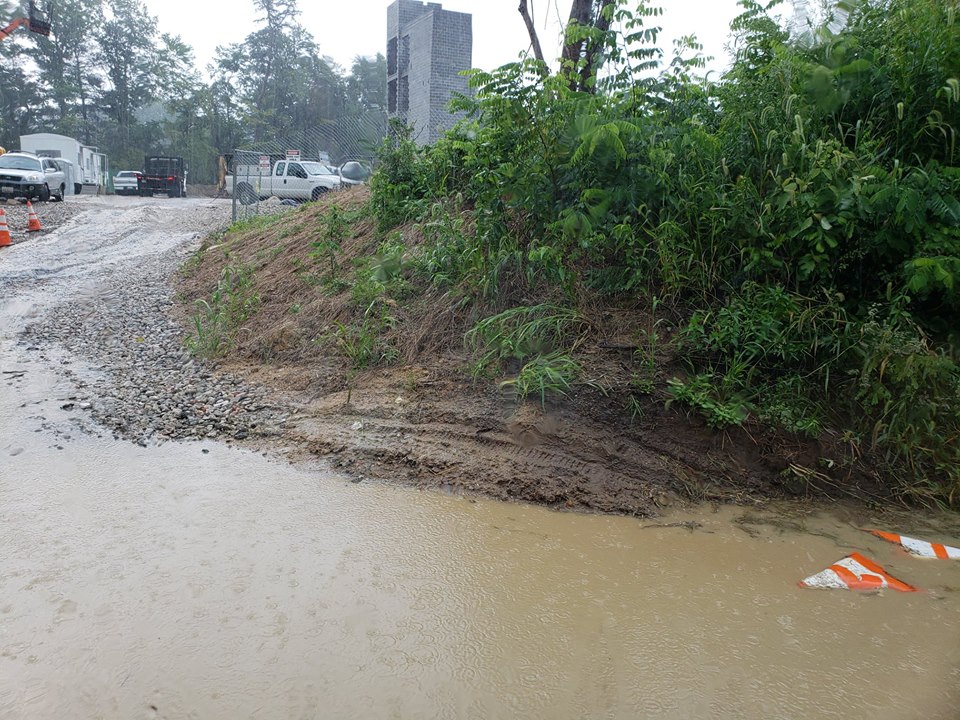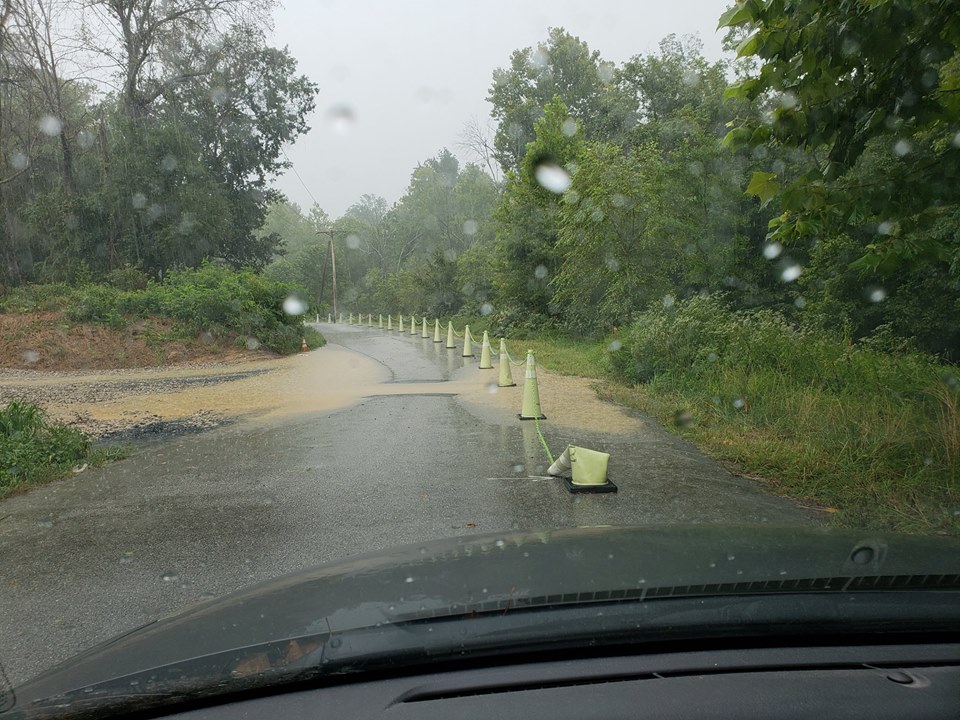
OPINION
The title #WeFloodToo first came to mind as I sat in the County Council meeting at which the one year building moratorium for Ellicott City was being discussed. (The #MeToo movement was still having a positive impact.) I felt it was significant that people from communities outside of Ellicott City were also commenting on the flooding in their own neighborhoods. The Valley Mede neighborhood was particularly hard hit. Again. I commented that anything learned about over-development’s effects in the Tiber watershed should also be applied to the rest of the County, because in fact, flooding is NOT a feature exclusive to Old Ellicott City.
Friday was the start of another long holiday weekend, not unlike the 2018 Memorial Day weekend. Here in the southeastern part of the county it was ushered in by torrential rain, accumulating several inches in under an hour, causing flooding throughout numerous communities. It wasn’t until I got a message from my daughter with photos of flooding at Guilford Road and Mary Lane that I realized the seriousness. Soon after I started seeing more photos and postings on Facebook about flooding occurring on roads, in yards, and in basements. I’m sure I wasn’t the only one to think, “Here we go again” and “I hope Ellicott City isn’t getting THIS.”
It’s hard not to think of Old Ellicott City ANYTIME it rains. But it is also appropriate to think of one’s own home and community, of friends living in low lying areas, of parcels recently stripped of trees and vegetation…….and of the many signs announcing pre-submission hearings for additional development.
When I saw pictures of the flooding at Guilford Road and Mission Road—‘the worst yet’ as described by a resident—I was particularly upset. https://www.facebook.com/jeff.walters.359/videos/10212687945889636/?t=13
I progressed to anger hearing there was also flooding at Mission and Route 1 and by the railroad bridge over Mission, just past where acres and acres of forest have been cleared for housing that will flank our proposed High School #13. The gentleman posting the video said “It appears that the sediment pond they built has overflown and partially collapsed and is spilling onto Mission Rd. Heavy silt in the water.” This will ultimately finds its way to the Little Patuxent River.
I certainly hope the County plans to correct these issues BEFORE school children are unable to either get to or return home from school safely. If this isn’t the poster child for a need to correct our development regulations and to take controlling storm water seriously, I don’t know what is!
But wait there’s more. Not far away is the construction site for a storage building along the Little Patuxent. Local citizens strongly opposed the permitting without any public notice of a facility whose entrance interrupts a portion of the Patuxent Branch trail, used for decades by area residents. For brevity here I will direct you to https://www.facebook.com/groups/FriendsGuilfordHistory/ , but will share photos taken by Wayne Davis which illustrate HoCo’s cavalier attitude toward commercial development adjacent to a flood plain and a branch of the Little Patuxent River.
Heavily silted stormwater flows from the construction site on to the roadway trail. It crosses and flows into the river which is just to the right of the cones and the vegetation.
Clearly no other area of HoCo has faced the repeated level of death and destruction as has OEC (to my knowledge). This makes one hesitant to say anything about the need for attention to storm water generated by over-development elsewhere. However we must admit the damaging effects of storm water resulting from HoCo’s addiction to dense development if we are to improve the situation. There is no easy Narcan fix, no antidote to the desire for more and more tax income. HoCo officials seek doses of greater and greater density, even knowing that it depletes our public facilities and emaciates our quality of life. The acceptance of ‘campaign contributions’ from developers feeds the addiction. Admitting the problem and making behavioral change is essential for what will doubtless be a long and difficult recovery. But we MUST begin now.
Fortunately the Patuxent, Middle Pax, and Little Pax don’t flood destructively frequently within the borders of Howard County. There have however been deaths at locations one doesn’t necessarily think of as ‘the river,’ such as South Entrance Road and Rt. 29. Residents of Savage remember vividly when Hurricane Agnes resulted in the destruction of the Foundry Street Bridge and when water has engulfed US1.
Those of us in Savage worry during each heavy rain about a resident whose home sits along the river. On the May weekend when OEC was destroyed, thankfully only her driveway was destroyed. I don’t know how I would have reacted to finding FISH on MY driveway! I was happy to share these photos with the Council.
Historically, Howard County, like much of Maryland, has made two very large mistakes regarding the management of storm water. First, throughout the era of the construction of Columbia, the approach was to get storm water away from developed properties and off to rivers as quickly as possible. (This speed has resulted in the erosion of streambanks necessitating costly remediation.) Next, the ‘NEW’ storm water regulations demanded water be kept on a newly developed property, to be cleaned before it flowed elsewhere. If the retention, bio retention, or micro-bio retention facilities function correctly, it is cleaned water that will still flow down steep slopes, picking up sediment and debris on its way through the watershed. Channels continue to fill in without dredging and attention. Culverts become blocked without attention. The substitution of impervious roofs, roads, sidewalks, etc. for open spaces of pervious fields and forests, places us literally on the path to destruction. We must wake up to the reality that we cannot be lenient in our approval of SW Management plans.
Flooding is one issue, but the health of our rivers is equally important. The Patuxent (Pax) River watershed occupies over 2/3 of this County, yet it is generally the Patapsco which gets the most attention. For several decades the Pax, which originates here in HoCo has had a D- rating. In 1980 the Counties to the south of us along the Pax insisted the state protect them from the pollution which Howard County created and sent downstream. (How embarrassing!) The State legislature authorized the creation of a Patuxent River Commission to protect the health of the river. Currently, the political power of developers in HoCo is threatening the Patuxent River Commission (PRC) itself, pressuring to eliminate the Commission’s ability to comment on private development regarded as deleterious to the watershed. (How embarrassing!)
You can read more on the situation at http://paxriverkeeper.org/the-only-state-river-commission-in-maryland-just-blinked/ Please consider signing the petition at http://paxriverkeeper.org/petition/ to show you care about the health of the Pax River and the future of the PRC—as well as its commission members who attempted to advise the HoCo Planning Board and Council on a most egregious case.
Insist that everyone throughout the County should be safe from uncontrolled storm water caused by uncontrolled development. Look carefully at which candidates are likely to put developers’ interests above the safety of residents—and meet me on the high road.
Susan Garber
Savage, Maryland
Get PERKS and Support Community Journalism | SUBSCRIBE

